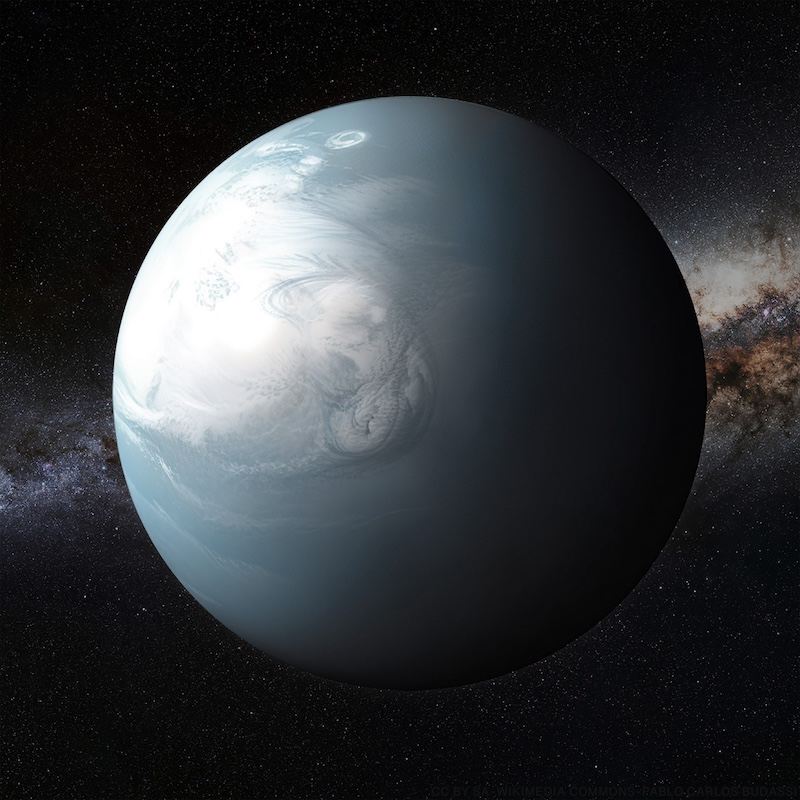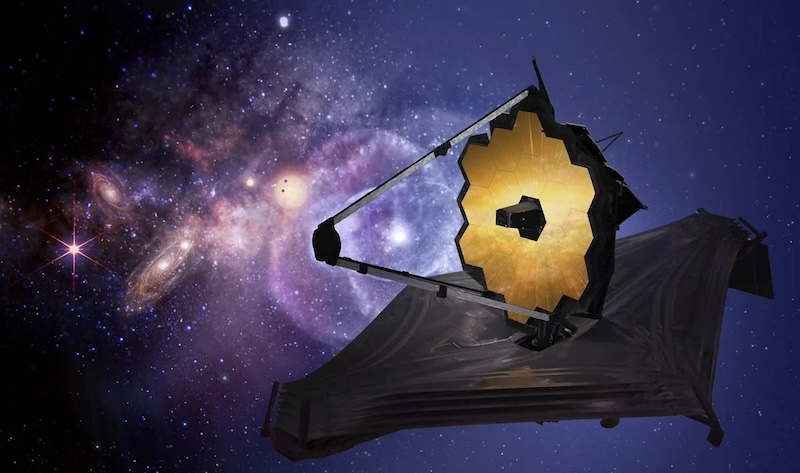
Meet TOI-270 d, a possible hycean world
- Recent research suggests that exoplanet TOI-270 d is likely a hycean planet – a world with a global ocean beneath a thick hydrogen atmosphere – located 70 light-years from Earth.
- But another research team thinks the planet is too hot to be considered hycean. Temperatures on its sunlit side might be as high as 7,200 degrees Fahrenheit (4,000 degrees Celsius).
- Both research groups also identified the presence of carbon disulfide, a compound potentially linked to biological activity on Earth, but also produced through alternative processes in hydrogen-rich atmospheres.
Hycean worlds are planets with global oceans beneath a thick hydrogen atmosphere. Scientists say they may be common in our galaxy. Researchers at the University of Cambridge in the U.K. said that the exoplanet TOI-270 d is likely a hycean planet. Their study is based on data from NASA’s James Webb Space Telescope. The Guardian newspaper first reported the tantalizing discovery on March 8, 2024. Another international research team, led by the University of Montreal in Canada, however, isn’t convinced yet that TOI-270 d really is an ocean world, saying it is likely too hot.
The U.K. researchers published their peer-reviewed paper in the journal Astronomy & Astrophysics on March 7, 2024. The Canadian and international research team submitted their paper to arXiv on March 5, 2024.
Is this sub-Neptune a hot ocean planet?
TOI-270 d is about twice the diameter of Earth and is 70 light-years away. Astronomers classify it as a sub-Neptune.
Nikku Madhusudhan at the University of Cambridge co-led the analysis of data about TOI-270 d. He explained that the ocean, if actually there, is likely quite hot:
The ocean could be upwards of 212 degrees Fahrenheit (100 degrees Celsius) or more. At high atmospheric pressure, an ocean this hot could still be liquid, but it’s not clear if it would be habitable.
The data from Webb shows that the atmosphere of the planet contains water vapor, methane and carbon dioxide. That is consistent with an atmosphere that is predominantly hydrogen, with a global water ocean beneath it. There is also a lack of ammonia, which also supports the hycean ocean world scenario. That’s because chemistry says it should occur naturally in a hydrogen atmosphere. But it would be depleted if there was an ocean because ammonia is highly soluble in water. Madhusudhan said:
One interpretation is that this is a so-called “hycean” world, with a water ocean under a hydrogen-rich atmosphere.
Too hot for an ocean?
The results are tantalizing, but not conclusive yet. With this in mind, another research team, led by Björn Benneke at the University of Montreal in Quebec, Canada, said that the planet would probably be hot for liquid water. They found the same gases in the atmosphere as the other team, but calculate the atmosphere could be much hotter, as much as 7,200 degrees Fahrenheit (4,000 degrees Celsius).
Benneke told The Guardian:
The temperature in our view is too warm for water to be liquid.
He and his team also think that there is too much water vapor in the atmosphere. They suggest that this wouldn’t leave enough water to form an ocean. Instead, the water might be in a supercritical state, called a supercritical fluid (SFC). A supercritical fluid is a substance at a temperature and pressure above its critical point, where distinct liquid and gas phases do not exist, but below the pressure required to compress it into a solid. This makes it more difficult to distinguish between a liquid and gas. Benneke said that:
… It’s almost like a thick, hot fluid.
In this scenario, instead of being a hycean ocean world, the planet would have a rocky surface with no ocean. The atmosphere would be dense with hydrogen and water vapor.
An ocean world unlike Earth
If TOI-270 d does have an ocean, conditions wouldn’t be exactly like those on Earth. This is because the planet is tidally locked to its star. Much as one side of the moon always faces Earth, one side of TOI-270 d always faces its star. This means that one side is always in sunlight while the other is in perpetual night. As a result, temperatures on the sunlight side are always hotter. As Madhusudhan said in The Guardian:
The ocean would be extremely hot on the day side. The night side could potentially host habitable conditions.
Also, the hydrogen atmosphere would have crushing pressure, tens or hundreds of times that of Earth’s atmosphere. Reminiscent of Venus, but even more so. The ocean itself would also be different to those on Earth, perhaps up to hundreds of times deeper than Earth’s oceans. The seabed, instead of rock, would likely be high-pressure ice, also known as Ice VI. Even deeper down, a rocky core.

Carbon disulfide
Along with the other atmospheric gases, both research teams also discovered something else: carbon disulfide. On Earth, it can be related to biological activity. But as the researchers point out, other processes can produce it as well, especially in hydrogen atmospheres. So it’s interesting, but not proof of life. As Madhusudhan explained:
We can’t tie [carbon disulfide] to biological activity. In a hydrogen-rich atmosphere, it is relatively easy to make it. But if we’re able to measure the unique molecule it’s promising that we should be able to measure habitable planets in the future.
We need to be extremely careful about how we communicate findings on this kind of object. It’s easy for the public to jump on to the idea that we’re finding life already.
The finding is similar to that of K2-18 b, another sub-Neptune with a deep hydrogen atmosphere. Last year, scientists announced a tentative detection of dimethyl sulfide (DMS) in its atmosphere.
On Earth, the molecule is only known to be produced by life, or in a laboratory. But the detection was weak, and scientists are still debating whether it actually exists on K2-18 b or not.
Bottom line: NASA’s Webb Space Telescope has discovered a possible hycean world, with a deep hydrogen atmosphere and a global water ocean. Or is this world too hot?
Source: Possible hycean conditions in the sub-Neptune TOI-270 d
Read more: Hycean planets might be habitable ocean worlds
Read more: Is this nearby exoplanet a water world? Or a mini-Neptune?











